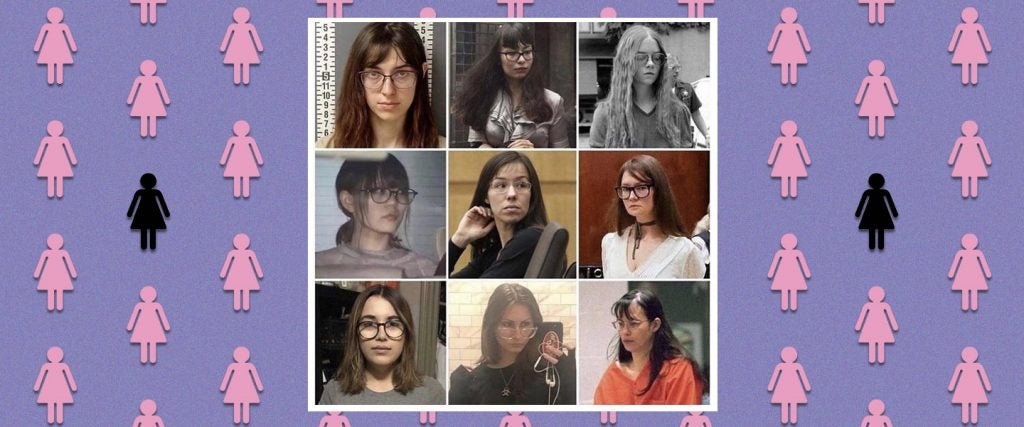What does a femcel look like?
Some say she doesn’t exist at all, others believe she’s next-level unattractive and a sizable faction think she could look like anyone. However, many say that she has an extremely particular look — maybe even her own phenotype. And in recent months, this specific imagined portrait of the femcel has become a meme:
As it’s understood online, the femcel phenotype has long, dark straight hair, glasses and sallow, makeup-free skin (frankly, she looks much like myself and many other women without makeup on or contacts in). But it isn’t just random photos of women who fit this bill that are chosen to represent the phenotype. Instead, many of the femcel phenotype memes utilize a selection of infamously criminal women, like Riley June Williams, who stole Nancy Pelosi’s laptop during the January 6th insurrection, Yuka Takaoka, who stabbed a male acquaintance in Tokyo in 2019 and Bella Janke, who’s accused of attempting to bully a mentally ill internet microcelebrity to perform incest on their incapacitated mother and commit suicide.
Per KnowYourMeme, these three women first became grouped as the femcel phenotype last August. From there, Twitter and Reddit helped expand the phenotype into a meme, including a larger swath of women.
Are any of these women actually femcels? It’s impossible to say. They, like many of the other women associated with the femcel phenotype, are more accurately described as either mentally ill, extremely online or both. Others have simply been involved in crimes. Some supposed femcel phenotypes, like 1978 school shooter Brenda Spencer, and Jodi Arias, who murdered her boyfriend in 2008, predate the incel phenomenon entirely. In the case of Arias, her sex life was a significant part of the discourse surrounding her trial. In fact, she was described as extremely sexually active with her partner, potentially a textbook “nymphomaniac,” a descriptor which, technically speaking, would make her the furthest thing from a femcel there is.
But despite these women being associated with crime and generally horrible behavior — and despite the fact that most femcels see themselves as too hideous or mentally unwell for sex or dating — the femcel phenotype is spoken of with desire and admiration. “The femcel phenotype got me foaming at the mouth,” one person tweeted back in April. Others have posted the meme with heart-eyes emojis, or made jokes about dying from “femcel phenotype pussy.” A few women have even posted their own selfies and bragged that they’d fit the look.
On TikTok, the word “femcel” has come to signify someone who spends too much time on the internet and who may be of questionable mental health. This is a departure from how femcels see themselves — again, unwanted and unloveable creatures unworthy of sexual or romantic attention — and the femcel phenotype meme seems to give these women the same treatment. Almost no attention is given to these women’s perceived sexlessness — if anything, as those aforementioned references highlight, there’s often an inherent sexualization at play.
However, like with inceldom writ large, sex is ultimately only one factor in a complicated toxic package. Not every man who doesn’t have sex becomes an incel, and not every woman with glasses and long hair fits the phenotype. Rather, it’s a persona that some have leaned into, or a series of crimes to which a figurehead has been assigned. In meme form, it’s merely a way for people to attempt to organize and make sense of women and the internet.
Does a femcel phenotype truly exist? Probably not. But the women associated with it and the hostility of niche online corners that brewed the concept of the femcel do, just the same.

